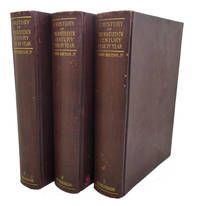
History of the Rottweiler: In 19th Century Literature
In 1894 in a book "Breeds of dog" Ludwig Beckmann does not devote a chapter to the rottweiler because he thought that the breed had no chance of survival: "The coat is most often single-colored reddish yellow, or black with yellow markings, the tail is almost always cropped, the ears are short and sagging, the size of a strong hunting dog. Unfortunately, due to the extension of the railroad lines these very typical dogs are disappearing more and more(. ) Butcher’s dogs from Württemberg and Rottweil also formed and still form an unchanged breed. It seems superfluous to give them more attention in view of their predicted disappearance"
Beckman was wrong. Admittedly, o "butcher’s dog from Württemberg" Nothing is known to us today, but "Rottweil the butcher’s dog" has survived and enjoys a growing interest among lovers of utility dogs.
H. v. Bylandt in his work "Dog breeds" (1894), describing the "butcher dogs", he shows 3 pictures and besides the common today black toed coat he also gives a pure yellow color with or without a black mask, which in his opinion allows us to assume a crossbreed with the German dog.
However it was not necessarily as Bylandt claims. In myths of all descendants "cattle grazing dogs" there were and there are puppies of red, yellow or brown colour – although they were never crossed with German shepherds.
At the turn of the century Richard Strebel in his work "German Dogs" dedicates a short chapter to rottweilers. So he also probably did not believe in the survival of the breed. Rottweilers were so rare at that time that he could only with difficulty acquire the skull of a dog of this breed. It cost him no less effort to get a picture of a rottweiler – as he wrote he was sent away "from Annas to Caiaphas without a noteworthy result". Therefore, he wrote, the breeding of this breed is so extremely rare, that if someone does not take care of it soon, it will be doomed to extinction. This fact – that the breed has become rare – is also confirmed by one of the first presidents of the Rottweiler Club Emil Stiefel in "Schweizer Hundesport und Jagd (1922): "And so in the early 90s of the last century there were no more than 5-7 dogs that could be shown in the show rings".
How different were the Rottweilers before the first war presented to the judge , testifies the example of a dog named "Kuroki von Zahringen" ( not marked with any number!). It received in 1918 an excellent grade and the first place, and four years later it was evaluated only as satisfactory. The judge then listed many defects, which after all the dog must also have had 4 years earlier.
The author of the drawings is Albert Kull, who ca. In 1883, the first standard of the rottweiler was created. Bylandt subsequently took it over as "the perfect german hunting dog" to your artwork "Breeds of dogs", 1894.
"The ideal German Shepherd for cattle rustling", painted by A.Kulla around 1883 (Bylandt – "Breeds of dogs)
A drawing made by Strebel shows an animal with a distinct type "a dog for herding cattle". If it did not have a short tail, it could be taken for a large Swiss shepherd dog (A. Strebel – " Die deutschen Hundem 1905)